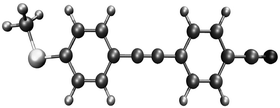The effect of solvent polarity on the photophysical properties of 4-cyano-(4′-methylthio)diphenylacetylene: A prototypic donor–acceptor system†
Abstract
The photophysical properties of the target compound are extremely sensitive to changes in

* Corresponding authors
a
Molecular Photonics Laboratory, School of Natural Sciences, University of Newcastle, Newcastle upon Tyne, UK
E-mail:
anthony.harriman@ncl.ac.uk
The photophysical properties of the target compound are extremely sensitive to changes in

 Please wait while we load your content...
Something went wrong. Try again?
Please wait while we load your content...
Something went wrong. Try again?
A. C. Benniston, A. Harriman and J. P. Rostron, Phys. Chem. Chem. Phys., 2005, 7, 3041 DOI: 10.1039/B506776F
To request permission to reproduce material from this article, please go to the Copyright Clearance Center request page.
If you are an author contributing to an RSC publication, you do not need to request permission provided correct acknowledgement is given.
If you are the author of this article, you do not need to request permission to reproduce figures and diagrams provided correct acknowledgement is given. If you want to reproduce the whole article in a third-party publication (excluding your thesis/dissertation for which permission is not required) please go to the Copyright Clearance Center request page.
Read more about how to correctly acknowledge RSC content.
 Fetching data from CrossRef.
Fetching data from CrossRef.
This may take some time to load.
Loading related content
